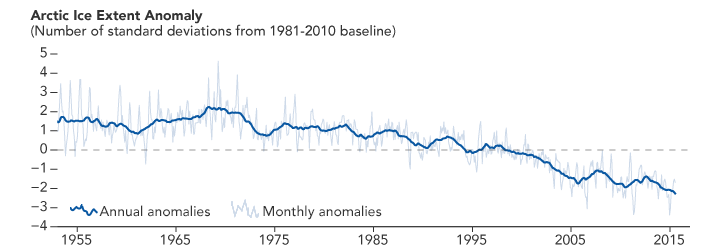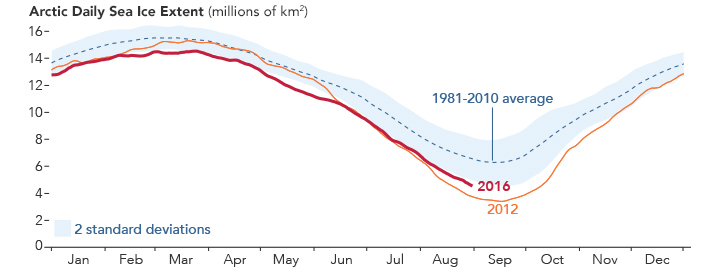

On September 28, 2016, science officials from around the world met in Washington, D.C., for the first White House Arctic Science Ministerial. The purpose was to “expand joint collaborations focused on Arctic science, research, observations, monitoring, and data-sharing.”
To commemorate the event, NASA Earth Observatory composed this mosaic—a satellite-based view of the Arctic. The images for this scene were captured on September 2, 2012, by the Visible Infrared Imaging Radiometer Suite (VIIRS) on the Suomi NPP satellite. The composite was compiled from 14 orbits of the satellite and multiple imaging channels, then stitched together to blend the edges of each satellite pass.
Scientists collect data and make observations of Earth’s polar areas from the ground and from aircraft during field campaigns. But the vantage point of space offers a consistent, wide view. For example, satellites have allowed scientists to monitor the decline of Arctic sea ice since 1979.
Arctic sea ice generally reaches its maximum extent each March and its minimum extent each September. This ice has historically ranged from roughly 14-16 million square kilometers (about 5.4-6.2 million square miles) in late winter to roughly 7 million square kilometers (about 2.7 million square miles) each September. In recent years, however, those numbers have been much lower.
The record lowest minimum ever observed in the satellite record occurred on September 16, 2012, when sea ice plummeted to 3.41 million square kilometers (1.32 million square miles). This image shows the area two weeks earlier. The edges of the ice pack are reasonably visible, as are some fractured areas. But some details are obscured by clouds. That’s where other satellite sensors—such as those that observe the microwaves emitted by the ice surface—come into play. The microwave energy radiated by ice passes through clouds, which means it can be measured year-round, even through the long polar night.


Reliable records based on shipping records and ice charts begin as far back as 1953. The top plot above shows sea ice anomalies—how much Arctic sea ice cover was above or below the norm—since that year. The second plot shows the daily sea ice extent, determined from the near-continuous satellite record since 1979. It shows how progress toward the annual minimum in 2016 (the second lowest in the satellite record) measured up to 2012, as well as the historical average (blue dashed line).
September 2012 was well below the previous record of 4.17 million square kilometers (1.61 million square miles) set in 2007, when Arctic sea ice extent broke all prior records more than a month before the end of melt season. Since the mid-2000s, low minimum extents in the Arctic have become the “new normal.”
Read more about sea ice in our newly updated fact sheet.NASA Earth Observatory image by Joshua Stevens, using VIIRS data from the Suomi National Polar-orbiting Partnership, and sea ice data courtesy of Walt Meier and the National Snow and Ice Data Center. Suomi NPP is the result of a partnership between NASA, the National Oceanic and Atmospheric Administration, and the Department of Defense. Caption by Kathryn Hansen.